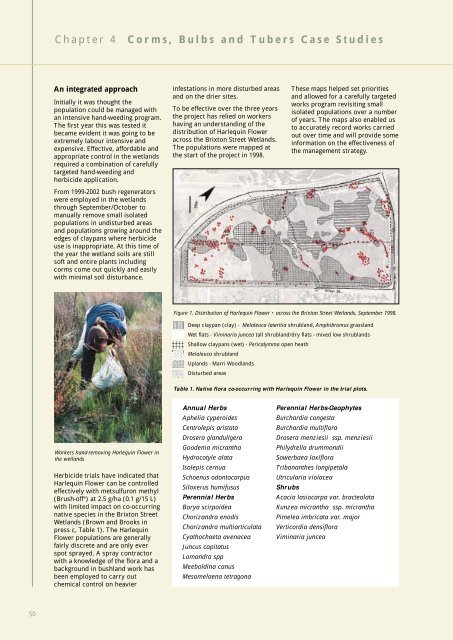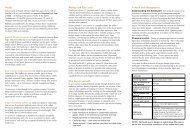Bushland Weeds Manual - Environmental Weeds Action Network
Bushland Weeds Manual - Environmental Weeds Action Network
Bushland Weeds Manual - Environmental Weeds Action Network
Create successful ePaper yourself
Turn your PDF publications into a flip-book with our unique Google optimized e-Paper software.
50<br />
Chapter 4 Corms, Bulbs and Tubers Case Studies<br />
An integrated approach<br />
Initially it was thought the<br />
population could be managed with<br />
an intensive hand-weeding program.<br />
The first year this was tested it<br />
became evident it was going to be<br />
extremely labour intensive and<br />
expensive. Effective, affordable and<br />
appropriate control in the wetlands<br />
required a combination of carefully<br />
targeted hand-weeding and<br />
herbicide application.<br />
From 1999-2002 bush regenerators<br />
were employed in the wetlands<br />
through September/October to<br />
manually remove small isolated<br />
populations in undisturbed areas<br />
and populations growing around the<br />
edges of claypans where herbicide<br />
use is inappropriate. At this time of<br />
the year the wetland soils are still<br />
soft and entire plants including<br />
corms come out quickly and easily<br />
with minimal soil disturbance.<br />
Workers hand-removing Harlequin Flower in<br />
the wetlands<br />
Herbicide trials have indicated that<br />
Harlequin Flower can be controlled<br />
effectively with metsulfuron methyl<br />
(Brush-off ® ) at 2.5 g/ha (0.1 g/15 L)<br />
with limited impact on co-occurring<br />
native species in the Brixton Street<br />
Wetlands (Brown and Brooks in<br />
press c, Table 1). The Harlequin<br />
Flower populations are generally<br />
fairly discrete and are only ever<br />
spot sprayed. A spray contractor<br />
with a knowledge of the flora and a<br />
background in bushland work has<br />
been employed to carry out<br />
chemical control on heavier<br />
infestations in more disturbed areas<br />
and on the drier sites.<br />
To be effective over the three years<br />
the project has relied on workers<br />
having an understanding of the<br />
distribution of Harlequin Flower<br />
across the Brixton Street Wetlands.<br />
The populations were mapped at<br />
the start of the project in 1998.<br />
These maps helped set priorities<br />
and allowed for a carefully targeted<br />
works program revisiting small<br />
isolated populations over a number<br />
of years. The maps also enabled us<br />
to accurately record works carried<br />
out over time and will provide some<br />
information on the effectiveness of<br />
the management strategy.<br />
Figure 1. Distribution of Harlequin Flower • across the Brixton Street Wetlands, September 1998.<br />
Deep claypan (clay) - Melaleuca lateritia shrubland, Amphibromus grassland<br />
Wet flats - Viminaria juncea tall shrubland/dry flats - mixed low shrublands<br />
Shallow claypans (wet) - Pericalymma open heath<br />
Melaleuca shrubland<br />
Uplands - Marri Woodlands<br />
Disturbed areas<br />
Table 1. Native flora co-occurring with Harlequin Flower in the trial plots.<br />
Annual Herbs Perennial Herbs-Geophytes<br />
Aphelia cyperoides Burchardia congesta<br />
Centrolepis aristata Burchardia multiflora<br />
Drosera glanduligera Drosera menziesii ssp. menziesii<br />
Goodenia micrantha Philydrella drummondii<br />
Hydrocotyle alata Sowerbaea laxiflora<br />
Isolepis cernua Tribonanthes longipetala<br />
Schoenus odontocarpus Utricularia violacea<br />
Siloxerus humifusus Shrubs<br />
Perennial Herbs Acacia lasiocarpa var. bracteolata<br />
Borya scirpoidea Kunzea micrantha ssp. micrantha<br />
Chorizandra enodis Pimelea imbricata var. major<br />
Chorizandra multiarticulata Verticordia densiflora<br />
Cyathochaeta avenacea<br />
Juncus capitatus<br />
Lomandra spp<br />
Meeboldina canus<br />
Mesomelaena tetragona<br />
Viminaria juncea



